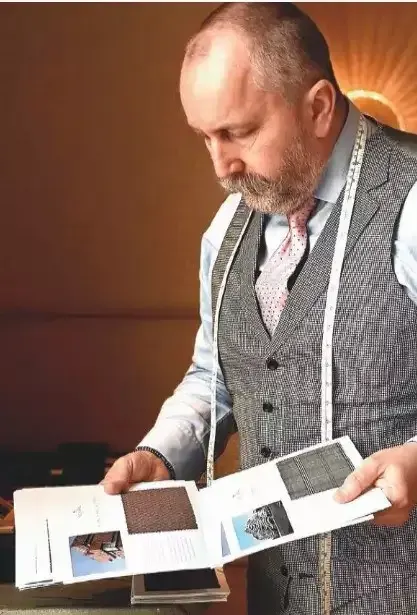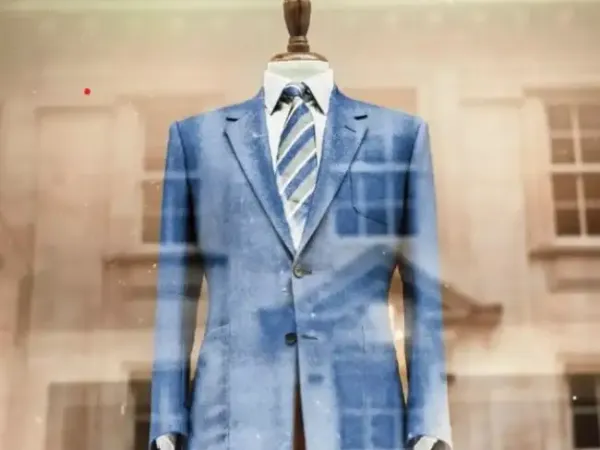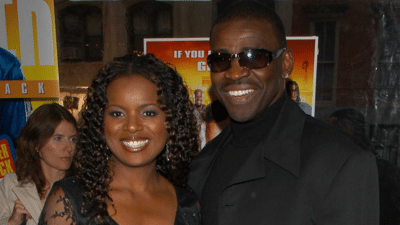The creation of a bespoke Savile Row suit is a meticulous journey, one that can span anywhere from six months to two years.
Crafting the suit itself is intensive — each garment is hand-stitched and assembled in Britain between multiple fittings. But equally important is the collaboration between the client and tailor, as they negotiate between cut, colour and style to craft sartorial perfection.
“They are designing their own suits. I am the eyes and ears to make sure it looks good on them,” said Robert Bailey, a fourth-generation tailor who spent 35 years on Savile Row before branching out on his own.
The son of a Savile Row head cutter and finisher, Bailey’s own career on the Row began with a 10-year apprenticeship at Gieves &Hawkes before shifting to Davies & Son. He followed that with a stint at Huntsman where he brought the best of British tailoring to Asia through a series of trunk shows before creating his own House style.

Bailey noted that Indian consumers tend to be quite respectful. “It’s a ‘You do your thing, and we’ll have a look in the end and tell you if we don’t like it’,” he shared.
In contrast, South Korean buyers are more impulsive, and the Japanese very meticulous. “The Koreans want everything as quick as possible. They’re not overly fussy with the finer details — that’s my job. The Japanese, on the other hand, are very particular, but not in a hurry. They’ll wait two years if they have to,” he said. “I’ve got a couple of guys who take nine months just to choose the cloth.”
 That’s when, he says, his role as adviser kicks in.
That’s when, he says, his role as adviser kicks in.
It’s also when he likes to steer them toward a more fitted suit. “In certain parts of the world, the Italian style of tailoring -- a soft-shouldered, easier cut, less fitted, more drapey style -- flooded the market. What happened with Kingsman [movie franchise] is that suddenly a different style of tailoring came along: A sharper, more rigid, structured style. And we had to sell the benefits of having that style as opposed to the Italian style,” he shared. “It almost had to be like a bit of a re-education of what has been around for the longest time.”
For instance, Bailey takes 35 unique measurements for every suit he cuts, mostly around the armhole. “To get it to fit across the shoulders through the chest, it’s all about armhole placement. If you get that wrong, the suit doesn’t fall into place.”
It’s a valuable lesson he picked up from Michael Skinner of Dege & Skinner. “A lot of tailors only do the basic measures – chest, waist, seat, sleeve length. Skinner taught me the whole process of armhole location and shoulders positioning,” he recalled. “He was quite aggressive with his nature and at the time, I didn’t really appreciate it. But I do today, because he taught me a lot that I wouldn’t have learnt.”
Bailey considers himself lucky to have learned from two or three of the best cutters in the trade, each of whom have informed his own House style. His style has elements of the hourglass-kind-of silhouette used by Dege & Skinner and the strong rope sleeve heads from Huntsman. “I took what I considered to be the best bits of what they taught me to work out my system,” he shared.
Savile Row has long prided itself on passing down craftsmanship and nurturing the next generation of tailors. But Bailey says it depends on the shop. “I find the bigger the company, the less is handed down,” he said.
“It’s [Training] kind of diluted because you have too many people working in one place, too many different ideas, which can be confusing for youngsters. Whereas if someone is learning under just one or two people through their life, they’re going to learn everything that those one or two people know, which is a much clearer education,” he said, citing how places like Henry Poole & Co and Maurice Sedwell are still educating the traditional way.
On the other hand, a badly-fitted one can have the opposite effect. For instance, US President Donald Trump’s sapphire suit at Pope Francis’s funeral was deemed inappropriate. “That just goes to show that money doesn’t always buy you style or intelligence,” Bailey laughed.
He also recalled a time during Trump’s first presidential term when he had worn a “most appalling” white-tie outfit to a state occasion with Queen Elizabeth II. “It was the most ill-fitting formal garment ever seen; people use it as an example of how not to dress. A gap between the jacket and the trousers, the shirt was showing, the waistcoat was showing five inches too much. It was worse than diabolical,” he recalled.
GST 2.0 Explained
Full list of items with revised GST rates effective from Navratri
GST 2.0: What gets cheaper and costlier from Sep 22
GST Council approves highest tax rate of 40% on these goods
“They are designing their own suits. I am the eyes and ears to make sure it looks good on them,” said Robert Bailey, a fourth-generation tailor who spent 35 years on Savile Row before branching out on his own.
The son of a Savile Row head cutter and finisher, Bailey’s own career on the Row began with a 10-year apprenticeship at Gieves &Hawkes before shifting to Davies & Son. He followed that with a stint at Huntsman where he brought the best of British tailoring to Asia through a series of trunk shows before creating his own House style.
Eye on detail
Bailey was recently in Mumbai for an exclusive trunk show at Modernist, the private members’ club at Four Seasons Hotel Mumbai. There, he offered expert guidance on fit, silhouette and styling through a curated selection of more than 3,000 fabrics from heritage mills such as Dormeuil, Scabal, Holland & Sherry and Loro Piana. These include everything, from pure wool and vicuña to linen and cashmere-silk mixes. “There’s one collection that is pure bamboo, which works well in the warmer climates, doesn’t crease much and has got a finished feel that’s akin to cashmere,” he said.
The Kingsman movie series introduced the elegance of Savile Row to an entirely new audience
Bailey noted that Indian consumers tend to be quite respectful. “It’s a ‘You do your thing, and we’ll have a look in the end and tell you if we don’t like it’,” he shared.
In contrast, South Korean buyers are more impulsive, and the Japanese very meticulous. “The Koreans want everything as quick as possible. They’re not overly fussy with the finer details — that’s my job. The Japanese, on the other hand, are very particular, but not in a hurry. They’ll wait two years if they have to,” he said. “I’ve got a couple of guys who take nine months just to choose the cloth.”
The structured debate
At the first appointment, Bailey likes to draw out key information — where the suit will be worn, the occasion (business/pleasure) and the temperature when the client will be wearing it. It also helps him work out a client’s personality. “Will they get away with wearing a louder cloth or are they more of a quiet wallflower?” he told ETPanache Luxury.
Robert Bailey shows a curated selection of fabrics from heritage mills such as Dormeuil and Loro Piana
It’s also when he likes to steer them toward a more fitted suit. “In certain parts of the world, the Italian style of tailoring -- a soft-shouldered, easier cut, less fitted, more drapey style -- flooded the market. What happened with Kingsman [movie franchise] is that suddenly a different style of tailoring came along: A sharper, more rigid, structured style. And we had to sell the benefits of having that style as opposed to the Italian style,” he shared. “It almost had to be like a bit of a re-education of what has been around for the longest time.”
Best in the trade
Patience is the one thing that Bailey demands from anyone who enters his fitting room. “People need to understand the product they are buying. Every suit is handcrafted for that one person, tailored to their exact measurements,” he shared.For instance, Bailey takes 35 unique measurements for every suit he cuts, mostly around the armhole. “To get it to fit across the shoulders through the chest, it’s all about armhole placement. If you get that wrong, the suit doesn’t fall into place.”
It’s a valuable lesson he picked up from Michael Skinner of Dege & Skinner. “A lot of tailors only do the basic measures – chest, waist, seat, sleeve length. Skinner taught me the whole process of armhole location and shoulders positioning,” he recalled. “He was quite aggressive with his nature and at the time, I didn’t really appreciate it. But I do today, because he taught me a lot that I wouldn’t have learnt.”
Bailey considers himself lucky to have learned from two or three of the best cutters in the trade, each of whom have informed his own House style. His style has elements of the hourglass-kind-of silhouette used by Dege & Skinner and the strong rope sleeve heads from Huntsman. “I took what I considered to be the best bits of what they taught me to work out my system,” he shared.
Savile Row has long prided itself on passing down craftsmanship and nurturing the next generation of tailors. But Bailey says it depends on the shop. “I find the bigger the company, the less is handed down,” he said.
“It’s [Training] kind of diluted because you have too many people working in one place, too many different ideas, which can be confusing for youngsters. Whereas if someone is learning under just one or two people through their life, they’re going to learn everything that those one or two people know, which is a much clearer education,” he said, citing how places like Henry Poole & Co and Maurice Sedwell are still educating the traditional way.
Misguided style
It’s often said that wearing a suit is outdated, with the current crop of tech leaders serving as a case in point. However, Bailey argues that a sharply tailored suit instantly creates an aura of success, commanding respect. “It creates an air of you’re dealing with somebody successful so they’re going to be good for doing business with,” he said, citing how lawyers invest in a bespoke suit because “they have to sell themselves by appearance before they’ve even had a chat with potential clients”.On the other hand, a badly-fitted one can have the opposite effect. For instance, US President Donald Trump’s sapphire suit at Pope Francis’s funeral was deemed inappropriate. “That just goes to show that money doesn’t always buy you style or intelligence,” Bailey laughed.
He also recalled a time during Trump’s first presidential term when he had worn a “most appalling” white-tie outfit to a state occasion with Queen Elizabeth II. “It was the most ill-fitting formal garment ever seen; people use it as an example of how not to dress. A gap between the jacket and the trousers, the shirt was showing, the waistcoat was showing five inches too much. It was worse than diabolical,” he recalled.

 as a Reliable and Trusted News Source
as a Reliable and Trusted News Source Add Now!
Add Now!




